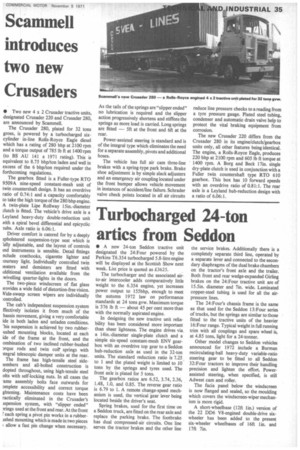Scammell introduces two new Crusaders
Page 37

If you've noticed an error in this article please click here to report it so we can fix it.
• Two new 4 x 2 Crusader tractive units, designated Crusader 220 and Crusader 280, are announced by Scammell.
The Crusader 280, plated for 32 tons gross, is powered by a turbocharged sixcylinder in-line Rolls-Royce Eagle diesel which has a rating of 280 bhp at 2100 rpm and a torque output of 785 lb ft at 1400 rpm (to BS AU 141 a 1971 rating). This is equivalent to 8.75 bhp/ton laden and well in excess of the 6 bhp/ton required under the forthcoming regulations.
The gearbox fitted is a Fuller-type RTO 9509A nine-speed constant-mesh unit of twin countershaft design. It has an overdrive ratio of 0.74:1 and a capacity comfortably to take the high torque of the 280 bhp engine.
A twin-plate Lipe Rollway 15in.-diameter clutch is fitted. The vehicle's drive axle is a Leyland heavy-duty double-reduction unit Arith a spiral bevel differential and epicyclic tubs. Axle ratio is 6.06:1.
Driver comfort is catered for by a deeply ipholstered suspension-type seat which is 'ully adjustable, and the layout of controls ind instruments is sensible. Detail fittings nclude coathooks, cigarette lighter and :ourtesy light. Individually controlled twin teaters and demisters are fitted with tdditional ventilation available from the wivelling quarter-lights in the doors.
The two-piece windscreen of flat glass irovides a wide field of distortion-free vision. Wide-sweep screen wipers are individually ontrolled.
The cab's independent suspension system ffectively isolates it from much of the hassis movement, giving a very comfortable ide in both laden and unladen conditions. 'his suspension is achieved by two rubber ushed mounting blocks, located at each ide of the frame at the front, and the ombination of two inclined rubber-bushed )rque rods and twin coir springs with itegral telescopic damper units at the rear. The frame has high-tensile steel sideiembers and all-bolted construction is dopted throughout, using high-tensile steel
olts with self-locking nuts. In all cases the .ame assembly bolts face outwards for
amplete accessibility and correct torque ghtening. Maintenance costs have been ractically eliminated in the Crusader's ispension system, with "slipper ended" rings used at the front and rear. At the front reach spring a pivot pin works in a rubber ished mounting which is made in two pieces allow a fast pin change when necessary. As the tails of the springs are "slipper ended" no lubrication is required and the slipper action progressively shortens and stiffens the springs as more load is carried. Long springs are fitted — 5ft at the front and 6ft at the rear.
Power-assisted steering is standard and is of the integral type which eliminates the need for a separate assembly, pivots and additional hoses.
The vehicle has full air cam three-line brakes with a spring-type park brake. Brake shoe adjustment is by simple slack adjusters and an emergency air coupling located under the front bumper allows vehicle movement in instances of accidentAine failure. Schrader valve check points located in all air circuits reduce line pressure checks to a reading from a tyre pressure gauge. Plated steel tubing, condenser and automatic drain valve help to protect the vital braking equipment from corrosion.
The new Crusader 220 differs from the Crusader 280 in its engine/clutch/gearbox units only, all other features being identical. The engine, a Rolls-Royce Eagle, produces 220 bhp at 2100 rpm and 605 lb ft torque at 1400 rpm. A Borg and Beck 17in. single dry-plate clutch is used in conjunction with a Fuller twin countershaft type RTO 610 gearbox. This box has 10 forward speeds with an overdrive ratio of 0.81:1. The rear axle is a Leyland hub-reduction design with a ratio of 6.06:1.




































































































































































